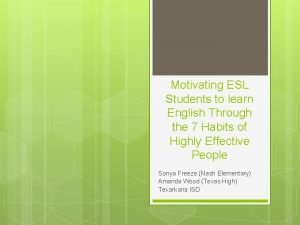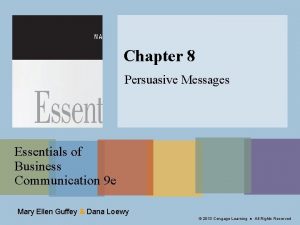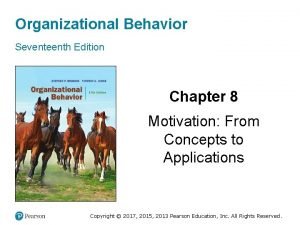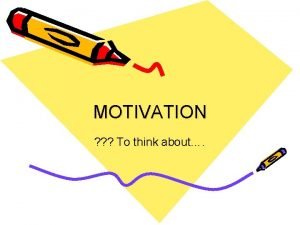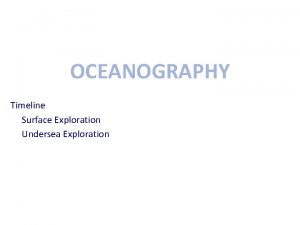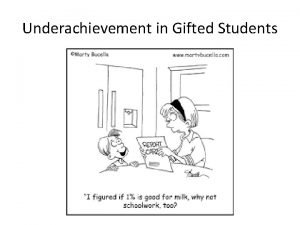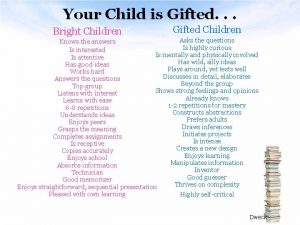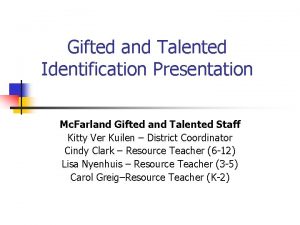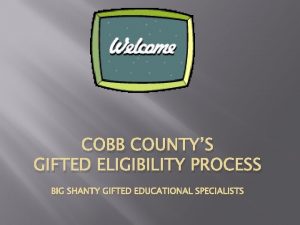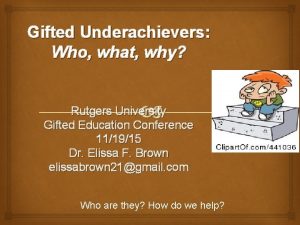An Exploration of the Factors that Motivate Gifted
















- Slides: 16

An Exploration of the Factors that Motivate Gifted and Talented Rural Students to Engage in STEM Isabella Baldwin Zurek, Takudzwa George, Clinton Oshipitan, Robert Luo, Amy Wang Advisor: Adrienne Coleman 1500 Sullivan Rd. , Aurora, IL 60506

Outline • Background • Case Study • Inquiry Question/Rationale • Methodology • Results • Future Plans Background Inquiry · Question · Methodology · Results· Future Plans 2 of 14 IMSAloquium 2017

Background Obstacles to STEM majors in rural areas ● Common parental and public misconceptions ● Misperceptions held by teachers ● Capacity issues outside classroom ● Obstacles external to school ● Obstacles in classroom Background · Inquiry Question ·Methodology · Results· Future Plans 3 of 14 IMSAloquium 2017

Case Study ● Chemical engineering undergraduate enrollment ● Illinois Institute of Technology ○ 0 Rural Students / 69 Student from Illinois ● University of Illinois – Chicago ○ 0 Rural Students / 174 Students from Illinois ● Northwestern University ○ 0 Rural Students / 37 Students from Illinois ● University of Illinois – Urbana-Champaign ○ 13 Rural Students / 368 Students from Illinois 25 Students came from Naperville Background · Inquiry Question ·Methodology · Results· Future Plans 3 of 14 IMSAloquium 2017

Inquiry Question/Rationale What are the factors that motivate rural students to engage in STEM (science, technology, engineering, and mathematics)? Background · Inquiry Question ·Methodology · Results· Future Plans 3 of 14 IMSAloquium 2017

Inquiry Question/Rationale cont. The Census Bureau’s urban-rural classification is fundamentally a delineation of geographical areas, identifying both individual urban areas and the rural areas of the nation. The Census Bureau’s urban areas represent densely developed territory, and encompass residential, commercial, and other non-residential urban land uses. ¨ ¤The Census Bureau identifies two types of urban areas: Urbanized Areas (UAs) of 50, 000 or more people; Urban Clusters (UCs) of at least 2, 500 and less than 50, 000 people. “Rural” encompasses all population, housing, and territory not included within an urban area Background · Inquiry Question ·Methodology · Results· Future Plans 4 of 14 IMSAloquium 2017

Inquiry Question/Rationale cont. Background · Inquiry Question ·Methodology · Results· Future Plans 5 of 14 IMSAloquium 2017

Methodology ● Qualitative study ○ Interviews and focus groups ● Current IMSA students, alumni, parents ● Contact over email, social media, in person ● Consent forms over Survey. Monkey ● Transcribe audio recordings Background · Inquiry Question ·Methodology · Results· Future Plans 6 of 14 IMSAloquium 2017

Demographics: Students, n=16 ● All two-parent households ● 6 (37. 5%) attended STEM program before IMSA, 10 (62. 5%) didn’t ● Racial/ethnic makeup ○ Asians: 2 (12. 5%) ○ Caucasians: 13 (81. 25%) ○ Biracial: 1 (6. 25%) ● Support System ○ Math team/gifted program: 2 (12. 5%) ○ Parents/family: 10 (62. 5%) ○ Little/none: 4 (25%) ● Reasons for enrolling in IMSA ○ Lack of challenge/resources, desire for better education Background · Inquiry Question ·Methodology · Results· Future Plans 7 of 14 IMSAloquium 2017

Demographics: Parents, n=21 ● How many are in STEM careers? ○ 8 of the 21 parents surveyed had STEM careers ● Family’s socioeconomic status ○ Lower Class: 3 parents (14. 29%) ○ Middle Class: 17 parents (80. 95%) ○ Upper Class: 1 parent (4. 76%) ● Why did your child choose to enroll in a gifted, residential STEM high school? ○ Pursue an interest in science or math ○ To be challenged academically Background · Inquiry Question ·Methodology · Results· Future Plans 8 of 14 IMSAloquium 2017

Results Prompt: Research suggests that there is a gap in STEM majors/careers in which rural students do not major in or enter STEM fields as often as suburban or urban students. Why do you think this gap exists? “Teacher gives you essentially exactly what’s on the test, you regurgitate it back up, and then you dismiss it until the final. And I feel like I was very bored with that, that to do anything, I didn’t feel like I was learning anything. . ” -Anonymous Student Background · Inquiry Question · Methodology · Results· Future Plans 9 of 14 IMSAloquium 2017

Results cont. Prompt: Describe your motivation to pursue or engage in STEM education. “. . . it was just the coolest thing to walk in and have an entire school of people who liked school. . . the school I came from, the people dreaded being there. On a given day, 80% might show up and they would all text through class, or sleep through class, pass notes because a lot of them couldn’t afford phones, which is a sad reality. ” -Anonymous Student Inquiry Question · Methodology · Results · Future Plans 10 of 14 IMSAloquium 2017

Results cont. Prompt: Discuss your perception of rural students engaged in or trying to pursue STEM. “I didn’t want their excitement for math and science to kind of be extinguished through bad instruction or just getting to college unprepared and just being supremely out qualified by others. ” -Anonymous Parent “It was a lot easier to get him enrolled in like a basketball clinic or football clinic or baseball clinic [than it was to find STEM programs]” -Anonymous Parent Background · Inquiry Question ·Methodology · Results· Future Plans 11 of 14 IMSAloquium 2017

Future Plans ● Analyze data for common themes, patterns, and trends by group (parents, students, alumni) ● Submit final article to Illinois Association for Gifted Children Journal in October ● Proposal to present at conference in beginning of 2018 Background · Inquiry Question ·Methodology · Results· Future Plans 12 of 14 IMSAloquium 2017

References Carnegie Science Center. (2014). Work to do: The role of STEM education in improving the tri-state region’s workforce. Pittsburgh, PA: Campos Inc. Rural Counties in Illinois [PDF]. (2013, February 28). U. S. Office of Management and Budget. Versypt, Joel J. , & Versypt, Ashlee N. Ford. (2013). Mapping Rural Students’ STEM Involvement: Case Studies of Chemical Engineering Undergraduate Enrollment in the States of Illinois and Kansas. ASEE Annual Conference and Exposition. Retrieved from https: //www. engr. uky. edu/~aseeched/papers/2013/7257. pdf. Background · Inquiry Question ·Methodology · Results· Future Plans 13 of 14 IMSAloquium 2017

Thank you! Dr. Adrienne Coleman, Ed. D. ● Multicultural Education Specialist, Illinois Mathematics and Science Academy ● Board Member, Illinois Association for Gifted Children acoleman@imsa. edu 630. 907. 5079 Professional Field Services Background · Inquiry Question ·Methodology · Results· Future Plans 14 of 14 IMSAloquium 2017
 Sau thất bại ở hồ điển triệt
Sau thất bại ở hồ điển triệt Thể thơ truyền thống
Thể thơ truyền thống Hãy nói thật ít để làm được nhiều
Hãy nói thật ít để làm được nhiều Thơ thất ngôn tứ tuyệt đường luật
Thơ thất ngôn tứ tuyệt đường luật Tôn thất thuyết là ai
Tôn thất thuyết là ai Ngoại tâm thu thất chùm đôi
Ngoại tâm thu thất chùm đôi Walmart thất bại ở nhật
Walmart thất bại ở nhật Gây tê cơ vuông thắt lưng
Gây tê cơ vuông thắt lưng Block xoang nhĩ độ 2 type 1
Block xoang nhĩ độ 2 type 1 Tìm vết của mặt phẳng
Tìm vết của mặt phẳng How to motivate esl students
How to motivate esl students Persuasive message in business communication
Persuasive message in business communication Raleigh and rosse case study
Raleigh and rosse case study Set high expectations which inspire motivate and challenge
Set high expectations which inspire motivate and challenge How can employee involvement measures motivate employees
How can employee involvement measures motivate employees Motivate interest
Motivate interest Inspiration vs motivation
Inspiration vs motivation










